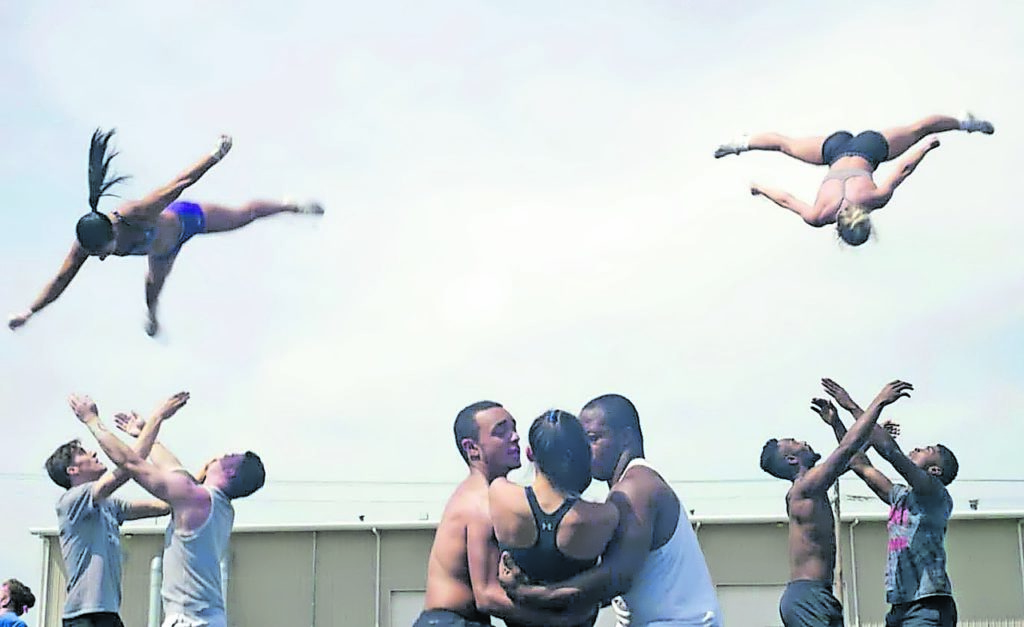Thrilling: The Navarro College cheer squad defies the notion of pompom girls performing sexy dance routines at sports events. Instead the young men and women execute spectacular gravity-defying cheer routines
Sequined, sunshiny, all-American girliness is the collective imagination of what a cheerleader is. She is simultaneously sexy and cute as she dances on the sideline, imploring the real athletes to “Be aggressive. Be-E aggressive”.
But in the recently-released Netflix docuseries Cheer, this image of the eternally optimistic, but otherwise ornamental, cheerleader is flipped on its head.
A deep dive into the world of competitive cheerleading in the United States, Cheer follows the Navarro College cheer squad as they train for the National Cheerleaders Association College Nationals in Daytona Beach, Florida — the only shot for the elite athletes to compete each year.
“Ouch,” Morgan Simianer says, her nasal vocal fry punctuating her pain.
This is the first word spoken by Simianer after the 43kg flyer is thrown three metres into the air and then caught by two of her teammates. And it’s the word that defines Cheer, which shows the Navarro cheerleaders perform death-defying stunts that will inevitably have a lasting toll on their bodies.
It’s being caught that hurts. Falling into the cradle-like, muscled embrace of the stunters leaves deep bruises on the ribs, threatening to shatter them.
Simianer is one of a 40-strong squad. By the end of the six-episode documentary only half of her teammates will have made it “on the mat” to compete at Daytona in a routine that will last just over two minutes.
The stakes are high. For many the competition will mark the end of their competitive cheerleading careers.
At its core, Cheer is about a sport that is so underestimated there are almost no opportunities to pursue it beyond college — yet these cheerleaders are willing to do almost anything for their moment in the sun.
The docuseries is buoyed by something far more compelling than the pursuit of accolades or future success — the often lifesaving effect of being part of a team.
The squad is led by Monica Aldama, who is the precise blend of Southern charm and grit that makes her both approachable and terrifying. When one of her cheerleaders is shown doubling over in pain or crying from exhaustion, the camera often cuts to Aldama who almost always takes a beat — cross-armed and stone-faced — before she rushes to their side.

Aldama uses this strictness to keep her often troubled team members fist tight, teaching that meticulous teamwork is the only thing stopping them from coming crashing down into the mat.
The pyramid, the apex moment of the final competition routine, requires absolute synergy. So during training, if one person falls to the ground, the entire squad must drop and give Aldama 50. This means team members are often seen diving in an effort to break someone else’s fall.
But Aldama’s hardness is balanced with the compassion she has for her cheerleaders in a world that has often been unkind to them.
“If I didn’t have cheer, I’d be upset at the world. Because I would be hurting others because I would be hurting myself,” Jeremiah “Jerry” Harris says, a tired smile never budging from his face.
Harris and his mother lived on food stamps until he was 16, when she died of lung cancer. Described as the heart of the team, Harris is often shown loudly encouraging his teammates from the sidelines, even when he is reminded that he is not as good as them at the sport he loves.
Between clips of the Navarro squad’s gruelling training routine, Cheer intermixes glimpses of the struggles many in the team have had to endure growing up poor, gay, angry or unloved.
This element of the docuseries threatens to nudge it into the realm of American Idol-style sentimentality. But there is no attempt to sugarcoat the effects of these traumas by polishing these characters with the shine of false redemption.
Bleach-blonde stoner Lexi Brumback joined the Navarro squad after she was arrested for beating up another woman in her front yard. Throughout Cheer the viewer watches her open up to the idea of being part of a team and being held accountable for her actions.
But despite being the best woman tumbler on the team, flinging herself across the mat with effortless precision, by the end of it all Brumback’s flaws win out.
Ultimately this is what holds Cheer together: the knowledge that no matter how hard one tries — no matter how flexible, strong or agile — in cheerleading, and in life, nothing is guaranteed.